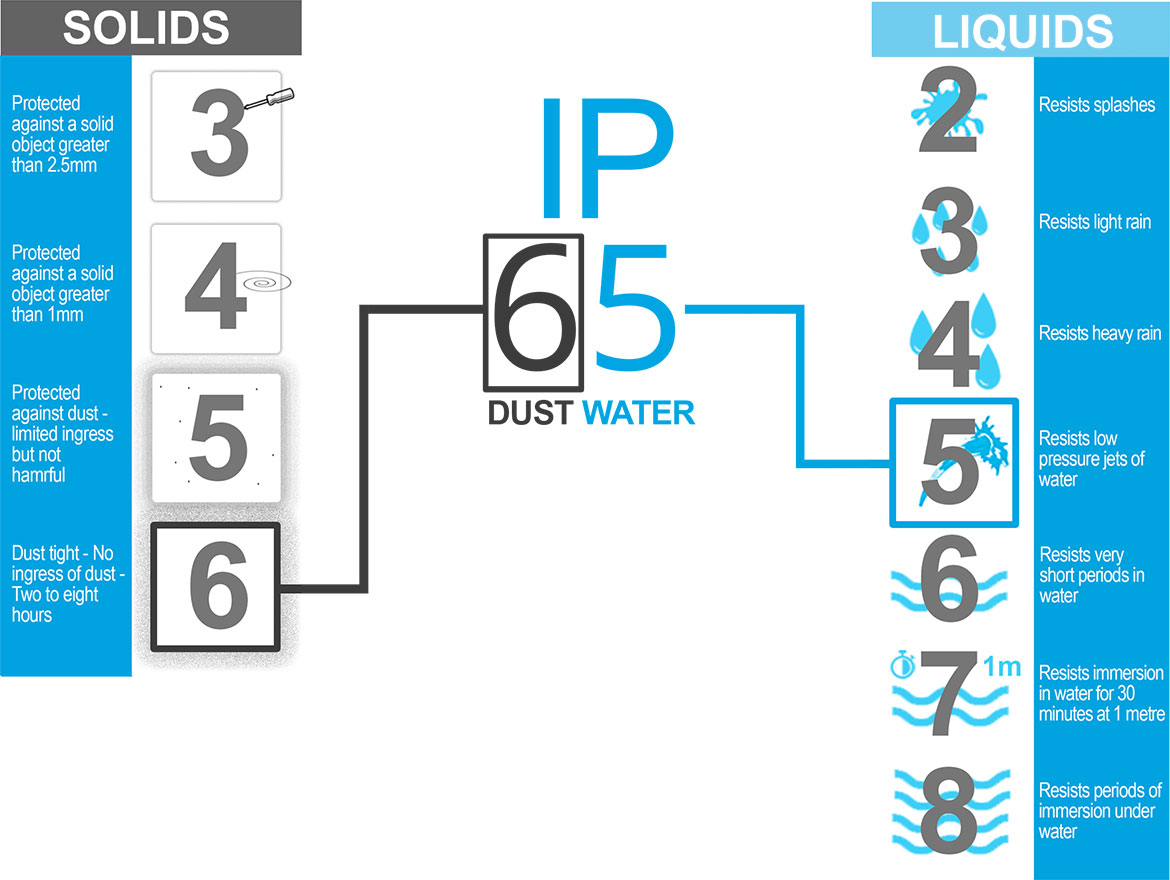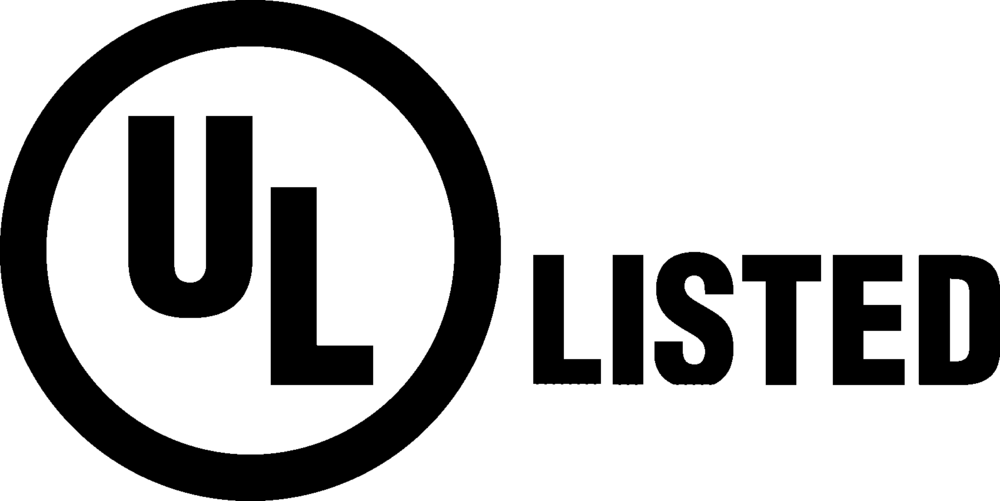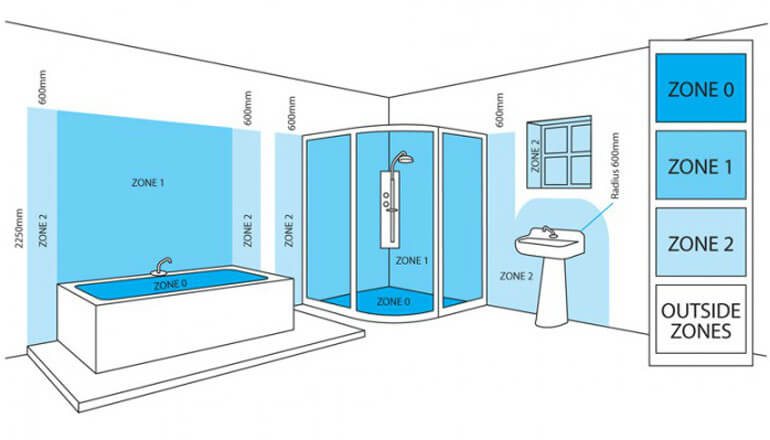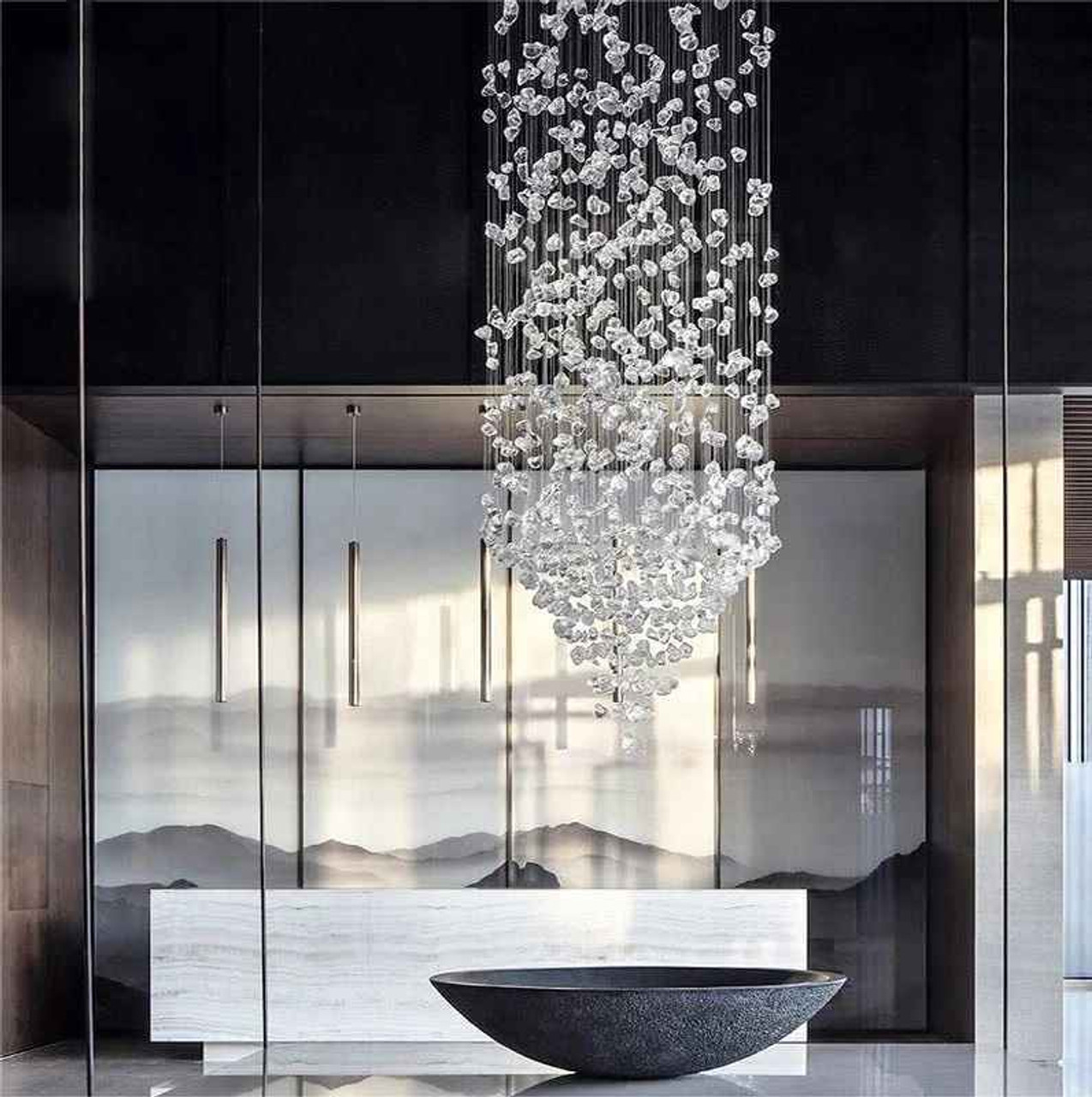What lights are suitable for bathrooms?
1st Aug 2024
What Lights Are Suitable For Bathrooms?
You cannot safely just install any fixture you want into a bathroom without carefully checking its suitability.
If you want to know what lights are suitable for bathrooms, then checking bathroom safety ratings for lighting fixtures are essential to ensure electrical safety in a potentially wet and humid environment. The safety ratings are classified based on the proximity of the fixture to water sources. Here are some common safety ratings:
1. IP (Ingress Protection) Rating: This rating consists of two digits. The first digit indicates the level of protection against solid objects, while the second digit indicates the level of protection against water. For bathrooms, look for a minimum IP44 rating, which provides protection against splashing water.
2. UL (Underwriters Laboratories) Rating: UL is a global safety certification organization. Look for lighting fixtures that are UL-listed for damp or wet locations. Damp-rated fixtures are suitable for areas with high humidity but no direct water contact, such as powder rooms. Wet-rated fixtures can withstand direct water exposure and are ideal for showers or areas near tubs.
3. Zone Ratings: In some regions, bathrooms are divided into zones based on their proximity to water sources. Each zone has specific safety requirements. Zone 0 refers to areas inside the bathtub or shower tray, where only low-voltage, low-energy fixtures with a specific IP rating are allowed. Zone 1 includes the area above the bathtub or shower tray, requiring fixtures with higher IP ratings. Zone 2 is the surrounding area around Zone 1, which typically requires IP44 or higher-rated fixtures.
It's important to ensure that the lighting fixtures installed in your bathroom have the appropriate safety ratings for the specific location to minimize the risk of electrical hazards. Consulting a qualified electrician or referring to local building codes can provide further guidance on safety requirements for bathroom lighting.
Bathroom IP Ratings For Light Fixtures

The IP (Ingress Protection) ratings for light fixtures indicate their level of protection against solid objects and water ingress. Here are the common IP ratings relevant to bathroom light fixtures:
1. IP20: Provides protection against solid objects larger than 12.5mm in diameter and offers no water protection. This rating is typically not suitable for bathroom use.
2. IP21: Provides protection against solid objects larger than 12.5mm in diameter and protection against vertically falling water droplets. However, it is not suitable for direct water exposure or humid environments like bathrooms.
3. IP44: Provides protection against solid objects larger than 1mm in diameter and protection against splashing water from any direction. IP44 is the minimum recommended rating for light fixtures in bathrooms, excluding the zone directly inside the bathtub or shower.
4. IP65: Offers dust-tight protection and protection against low-pressure water jets from any direction. This rating is suitable for light fixtures inside the shower area or above the bathtub.
5. IP67: Provides dust-tight protection and protection against temporary immersion in water up to a depth of 1 meter for a limited time. IP67-rated fixtures are suitable for wet areas in bathrooms, such as submerged lighting in bathtubs or Jacuzzis.
It's important to note that different regions or countries may have slightly varying requirements or classifications for bathroom IP ratings. Therefore, it is recommended to consult local building codes and regulations or seek professional advice to ensure compliance with the appropriate IP ratings for bathroom light fixtures in your specific location. Please contact the lighting manufacturer to know what lights are suitable for bathrooms.
Bathroom UL listings For Bathroom Lights

UL (Underwriters Laboratories) provides safety certifications for electrical products, including light fixtures. While UL does not specifically categorize ratings for bathroom light fixtures, they do provide listings for damp and wet locations. Here are the relevant UL ratings for light fixtures used in bathrooms:
1. UL Listed for Damp Locations: Fixtures with this listing are suitable for areas with high humidity, such as powder rooms or bathrooms without direct water exposure. They can withstand moisture but should not come into direct contact with water.
2. UL Listed for Wet Locations: Fixtures with this listing are designed to withstand direct water exposure. They are suitable for use in showers, above bathtubs, or in areas where there is a high probability of water contact. Wet-rated fixtures offer increased protection against moisture and water ingress.
UL listings for damp and wet locations indicate that the fixtures have undergone rigorous testing to meet safety standards in those specific environments. When choosing light fixtures for bathrooms, it's advisable to look for these UL listings to ensure electrical safety and compliance with local building codes.
It's important to note that UL listings may vary based on regional or country-specific standards, so it's recommended to consult local regulations or consult with a qualified electrician to ensure compliance with the appropriate UL ratings for bathroom light fixtures in your specific location.
UL (Underwriters Laboratories) is an American organization that provides safety certifications and listings for various products, including electrical and lighting fixtures. UL listings ensure that the products have been tested and meet specific safety standards and requirements. While UL is based in the United States, their certifications and listings are recognized and accepted in many other countries around the world. However, different countries have their own national safety certification organizations and standards. In the EU for example Bathroom lighting safety is based on the IP ratings and zonings. Please contact the lighting manufacturer to know what lights are suitable for bathrooms.
What Are Zone Ratings For Bathroom Lights?

Zone ratings for bathroom lights are classifications based on the proximity to water sources and the required level of safety. These zone ratings are commonly used in some regions to specify the appropriate lighting fixtures for different areas of the bathroom. The zones are typically categorized as follows:
1. Zone 0: This refers to the area inside the bathtub or shower tray itself. For this zone, only low-voltage, low-energy fixtures with specific IP (Ingress Protection) ratings are allowed. The IP rating requirement ensures adequate protection against direct water exposure.
2. Zone 1: This includes the area above the bathtub or shower tray up to a certain height. In this zone, fixtures must have a higher IP rating than those in Zone 0. They should provide increased protection against water ingress and splashing.
3. Zone 2: This zone extends horizontally around Zone 1 and covers the area adjacent to the bathtub or shower. For this zone, fixtures should have a minimum IP44 rating to protect against splashing water.
4. Zone 3: This is the area outside Zones 0, 1, and 2, typically covering the remaining space in the bathroom. There are no specific IP rating requirements for fixtures in this zone, but it's recommended to use fixtures with at least an IP20 rating for general protection against solid objects.
The specific requirements and regulations for zone ratings may vary depending on regional building codes or standards. It's important to consult local regulations or seek guidance from a qualified professional to ensure compliance with the appropriate zone ratings for bathroom lights in your specific location. Please contact the lighting manufacturer to know what lights are suitable for bathrooms.
The Types Of Lights For Bathrooms
When choosing lights for bathrooms, it is important to consider both functionality and aesthetics. Here are some suitable options:
1. Vanity Lights: These are commonly placed above the bathroom mirror to provide task lighting for grooming and makeup application. Wall-mounted vanity lights or vertical sconces on either side of the mirror are popular choices.
2. Ceiling Lights: Ceiling-mounted fixtures such as flush mount or semi-flush mount lights provide overall ambient lighting in the bathroom. They distribute light evenly throughout the space and are suitable for general illumination.
3. Recessed Lights: These are installed in the ceiling and provide focused and adjustable lighting. They work well for accent lighting or creating a soothing atmosphere in the bathroom.
4. Pendant Lights: Pendant lights can add a stylish and decorative touch to the bathroom. They are often used over freestanding bathtubs or in larger bathrooms with high ceilings to create a focal point and add visual interest.
5. Wall Sconces: Wall sconces placed on the side walls of the bathroom provide additional ambient or task lighting. They can be used to create a warm and inviting atmosphere.
6. LED Strip Lights: These flexible and energy-efficient lights can be installed along mirrors, under cabinets, or in recessed niches to provide subtle and indirect lighting. They are ideal for creating a soft glow or adding visual interest.
When selecting bathroom lights, it's essential to ensure they are rated for damp or wet environments to withstand moisture and humidity. Additionally, consider the colour temperature of the bulbs to achieve the desired ambiance, with warmer tones for a relaxing atmosphere and cooler tones for a bright and refreshing feel.
Do Bathroom Lights Need A Special Paint Finish To Prevent Rust?
Yes, it is advisable for paint finishes on bathroom lighting fixtures to be water-resistant to prevent rust and maintain their aesthetic appeal. Bathrooms are prone to high levels of humidity and moisture, which can accelerate the corrosion process on metal surfaces. Water-resistant paint finishes create a protective barrier, preventing water from seeping into the underlying metal and causing rust or other forms of deterioration.
Look for light fixtures with finishes specifically designed for bathroom use, such as moisture-resistant or corrosion-resistant coatings. These finishes are formulated to withstand the humid bathroom environment and resist the effects of moisture, reducing the likelihood of rust formation.
Additionally, proper care and maintenance of bathroom lighting fixtures can also contribute to their longevity. Regularly cleaning and drying the fixtures, especially after exposure to water, can help prevent the accumulation of moisture and minimize the risk of rust formation.
By selecting water-resistant paint finishes and maintaining good upkeep, you can help ensure that your bathroom lighting fixtures remain visually appealing and free from rust for an extended period.
What Types Of Metal Is Better For Use In Bathroom Lighting?
When it comes to choosing metals for bathroom lighting fixtures, it's important to consider their resistance to moisture and corrosion. Here are some metal options that are commonly used in bathroom lighting due to their durability and suitability for wet environments:
1. Stainless Steel: Stainless steel is a popular choice for bathroom lighting due to its excellent resistance to corrosion and moisture. It is highly durable, easy to clean, and maintains its appearance well over time.
2. Brass: Brass is known for its resistance to tarnishing and corrosion. It adds a touch of elegance to bathroom fixtures and can withstand the humid environment. However, it may require occasional polishing to maintain its lustrous appearance.
3. Aluminum: Aluminum is a lightweight and corrosion-resistant metal, making it a suitable choice for bathroom lighting. It is often used in modern and contemporary designs and can be finished in various ways to complement the overall aesthetic.
4. Copper: Copper has antimicrobial properties and is resistant to corrosion. It develops a unique patina over time, adding character to the fixtures. Copper can be an attractive choice for traditional or rustic bathroom designs.
It's important to note that the quality of the metal finish and proper maintenance are also crucial factors in preventing corrosion and maintaining the longevity of bathroom lighting fixtures. Regular cleaning, drying after use, and avoiding abrasive cleaners will help preserve the appearance and performance of the chosen metal.
Are LED's More Suitable For Bathrooms?
Yes, LED (Light-Emitting Diode) lights are generally considered more suitable for bathrooms due to their numerous advantages. Here are some reasons why LEDs are a popular choice for bathroom lighting:
1. Energy Efficiency: LEDs are highly energy-efficient, consuming significantly less electricity compared to traditional lighting options. This can lead to energy savings and reduced electricity costs.
2. Longevity: LEDs have a long lifespan, typically lasting much longer than traditional incandescent or fluorescent bulbs. This means less frequent bulb replacements, which is particularly convenient in hard-to-reach areas like bathroom fixtures.
3. Durability: LED lights are resistant to shocks, vibrations, and temperature fluctuations, making them durable and reliable for bathroom environments.
4. Instant On/Off: LEDs illuminate instantly when switched on, without any warm-up time. This is convenient in bathrooms where quick and reliable lighting is often needed.
5. Design Flexibility: LEDs come in various shapes and sizes, allowing for versatile and creative lighting designs. They can be used in recessed ceiling fixtures, vanity lights, mirror lighting, and other applications to enhance the aesthetic appeal of the bathroom.
6. Dimming Capability: Many LED lights are compatible with dimmer switches, offering adjustable brightness levels to create desired ambiance and mood lighting in the bathroom.
7. Safety: LEDs produce less heat compared to traditional bulbs, reducing the risk of burns or accidental contact with hot surfaces. They also do not contain hazardous materials like mercury, making them environmentally friendly.
Considering these factors, LED lights are a reliable and suitable choice for bathrooms, providing efficient, long-lasting, and safe lighting solutions.


